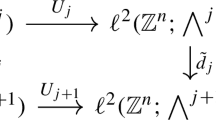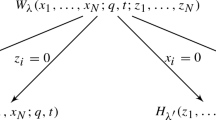Abstract
We present an explicit formula for the resolvent of the discrete Laplacian on the square lattice, and compute its asymptotic expansions around thresholds in low dimensions. As a by-product we obtain a closed formula for the fundamental solution to the discrete Laplacian. For the proofs we express the resolvent in a general dimension in terms of the Appell–Lauricella hypergeometric function of type C outside a disk encircling the spectrum. In low dimensions it reduces to a generalized hypergeometric function, for which certain transformation formulas are available for the desired expansions.
Similar content being viewed by others
References
Bhat, H.S., Osting, B.: Diffraction on the two-dimensional square lattice. SIAM J. Appl. Math. 70(5), 1389–1406 (2009/10)
Bühring, W.: Generalized hypergeometric functions at unit argument. Proc. Am. Math. Soc. 114(1), 145–153 (1992)
Bühring, W., Srivastava, H.M.: Analytic continuation of the generalized hypergeometric series near unit argument with emphasis on the zero-balanced series. Approximation Theory and Applications, Hadronic Press, Palm Harbor, FL, 17–35 (1998)
Ebisu, A.: Special values of the hypergeometric series. Mem. Am. Math. Soc. 248(1177) (2017)
Guttmann, A.J.: Lattice Green’s functions in all dimensions. J. Phys. A 43(30), 305205, 26 pp (2010)
Ito, K., Jensen, A.: A complete classification of threshold properties for one-dimensional discrete Schrödinger operators. Rev. Math. Phys. 27(1), 1550002, 45 pp (2015)
Ito, K., Jensen, A.: Branching form of the resolvent at threshold for ultra-hyperbolic operators and discrete Laplacians. J. Funct. Anal. 277(4), 965–993 (2019)
Isozaki, H., Korotyaev, E.: Inverse problems, trace formulae for discrete Schrödinger operators. Ann. Henri Poincare 13(4), 751–788 (2012)
Jensen, A., Nenciu, G.: A unified approach to resolvent expansions at thresholds. Rev. Math. Phys. 13(6), 717–754 (2001)
Jensen, A., Nenciu, G.: Erratum: “A unified approach to resolvent expansions at thresholds” [Rev. Math. Phys. 13 (2001), no. 6, 717–754]. Rev. Math. Phys. 16(5), 675–677 (2004)
Joyce, G.S.: Singular behaviour of the lattice Green function for the \(d\)-dimensional hypercubic lattice. J. Phys. A 36(4), 911–921 (2003)
Kapanadze, D.: Exterior diffraction problems for two-dimensional square lattice. Z. Angew. Math. Phys. 69(5), Art. 123, 17 pp (2018)
Lawler, G.F., Limic, V.: Random walk: a modern introduction. Cambridge Studies in Advanced Mathematics, 123. Cambridge University Press, Cambridge (2010)
Lynch, R.E.: Fundamental solutions of nine-point discrete Laplacians. A Festschrift to honor Professor Garrett Birkhoff on his eightieth birthday. Appl. Numer. Math. 10(3–4), 325–334 (1992)
Martin, P.A.: Discrete scattering theory: Green’s function for a square lattice. Wave Motion 43(7), 619–629 (2006)
Mangad, M.: Bounds for the two-dimensional discrete harmonic Green’s function. Math. Comput. 20, 60–67 (1966)
McCrea, W.H., Whipple, F.J.W.: Random paths in two and three dimensions. Proc. R. Soc. Edinb. 60, 281–298 (1940)
Morita, T.: Useful procedure for computing the lattice Green’s function–square, tetragonal, and bcc lattices. J. Math. Phys. 12, 1744–1747 (1971)
NIST Digital Library of Mathematical Functions. http://dlmf.nist.gov/, Release 1.0.23 of 2019-06-15. Online companion to [OLBC]
Nomura, Y., Taira, K.: Some properties of threshold eigenstates and resonant states of discrete Schrödinger operators. Ann. Henri Poincaré 21(6), 2009–2030 (2020)
Ray, K.: Green’s function on lattices. arXiv:1409.7806 [math-ph]
Rozenblum, G., Solomyak, M.: Spectral estimates for Schrödinger operators with sparse potentials on graphs. Problems in mathematical analysis. No. 57. J. Math. Sci. (N.Y.) 176(3), 458–474 (2011)
Saigo, M., Saxena, R.K.: Expansions of \({_4F_3}\) when the upper parameters differ by integers. Kyungpook Math. J. 38(2), 293–299 (1998)
Slater, L.J.: Generalized Hypergeometric Functions. Cambridge University Press, Cambridge (1966)
Vidūnas, R.: Specialization of Appell’s functions to univariate hypergeometric functions. J. Math. Anal. Appl. 355(1), 145–163 (2009)
Zucker, I.J.: 70+ years of the Watson integrals. J. Stat. Phys. 145(3), 591–612 (2011)
Acknowledgements
KI would like to thank Professors Naotaka Kajino, Yoshiaki Goto, Hideshi Yamane and Kanam Park for valuable comments. This work was initiated and finalized during KI’s visits to Aarhus University, and he would like to thank for their kind hospitality. KI was partially supported by JSPS KAKENHI Grant Number 17K05325. The authors were partially supported by the Danish Council for Independent Research | Natural Sciences, Grants DFF–4181-00042 and DFF–8021-0084B.
Author information
Authors and Affiliations
Corresponding author
Additional information
Publisher's Note
Springer Nature remains neutral with regard to jurisdictional claims in published maps and institutional affiliations.
Appendices
Comparison with Previous Results
1.1 Result from the Previous Paper [7]
In [7] we computed the singular parts of the resolvent expansions around all the thresholds in all the dimensions. They should coincide with the results of this paper. For a quick comparison here we review the results from [7] according to the present setting only for the low dimensions.
Theorem A.1
Let \(d=1\). There exists \({\mathcal {E}}_0(z,n)\) analytic in \(|z|<4\) such that for any \(z\in {\mathbb {C}}\setminus [0,4]\) with \(|z|<4\) and \(n\in {\mathbb {Z}}\)
Similarly, there exists \({\mathcal {E}}_1(z,n)\) analytic in \(|z-4|<4\) such that for any \(z\in {\mathbb {C}}\setminus [0,4]\) with \(|z-4|<4\) and \(n\in {\mathbb {Z}}\)
Theorem A.2
Let \(d=2\). There exists \({\mathcal {E}}_0(z,n)\) analytic in \(|z|<4\) such that for any \(z\in {\mathbb {C}}\setminus [0,8]\) with \(|z|<4\) and \(n\in {\mathbb {Z}}^2\)
There exists \({\mathcal {E}}_1(z,n)\) analytic in \(|z-4|<4\) such that for any \(|z-4|<4\) with \(\mathop {\mathrm {Im}}z>0\) and \(n\in {\mathbb {Z}}^2\)
There exists \({\mathcal {E}}_2(z,n)\) analytic in \(|z-8|<4\) such that for any \(z\in {\mathbb {C}}\setminus [0,8]\) with \(|z-8|<4\) and \(n\in {\mathbb {Z}}^2\)
1.2 Comparison of the Singular Parts
For \(d=1\) the singular parts of Theorem 2.2 and Theorem A.1 clearly coincide due to (2.1). Hence we examine only the case \(d=2\). We begin with the embedded threshold \(z=4\).
Corollary A.3
The singular parts from Theorems 2.3 and A.2 around \(z=4\) coincide, which is equivalent to the following relations: For all \(k\in {\mathbb {N}}_0\) and \(n\in {\mathbb {Z}}^2\)
and
Proof
Since Theorems 2.3 and A.2 provide asymptotic expansions of the same function, it is clear that their singular parts have to coincide.
Let us verify that this is equivalent to the asserted identities. For that we set
which are the coefficients of the singular part from Theorem A.2. First let \(j=2k\) be even, and then
Then the coincidence of the singular parts implies the first identity of the assertion for |n| even, and hence also for |n| odd. Next let \(j=2k+1\) be odd, and we have
Similarly to the above, the coincidence of the singular parts implies the first asserted identity for |n| odd, and hence also for |n| even. The converse is clear from the above argument, and we are done. \(\square \)
Remark
We do not try to give direct proofs of the identities from Corollary A.3. The identities in Corollary A.3 have been verified using the computer algebra system Maple.
Similarly we discuss the endpoint thresholds \(z=0,8\) as follows.
Corollary A.4
The singular parts from Theorems 2.4 and A.2 around \(z=0,8\) coincide, i.e., for all \(|w|<1\) and \((m,l)\in {\mathbb {Z}}^2\)
and for all \(|w|<1\) and \((m,l)\in {\mathbb {N}}_0^2\)
Proof
We can prove the assertion similarly to Corollary A.3. However, it requires fairly long computations, and we omit it. \(\square \)
Remark
In contrast to Corollary A.3 we have no idea how we could possibly directly prove the identities from Corollary A.4. However, they can be verified using the computer algebra system Maple, in this case for fixed but arbitrary values of m and l.
Renormalized Expectation of Random Work
Proof of (1.3)
It is elementary to compute \(P(X_k=n)\). In fact, we have
if \(k\ge |n|\) and \(k-|n|\) is even, and
otherwise. Then we obtain
Rights and permissions
About this article
Cite this article
Ito, K., Jensen, A. Hypergeometric Expression for the Resolvent of the Discrete Laplacian in Low Dimensions. Integr. Equ. Oper. Theory 93, 32 (2021). https://doi.org/10.1007/s00020-021-02648-2
Received:
Revised:
Published:
DOI: https://doi.org/10.1007/s00020-021-02648-2




